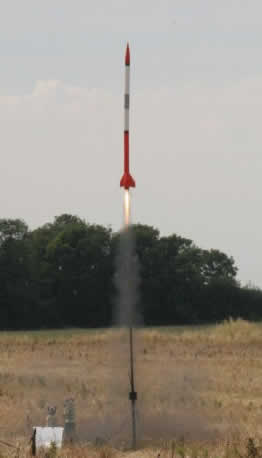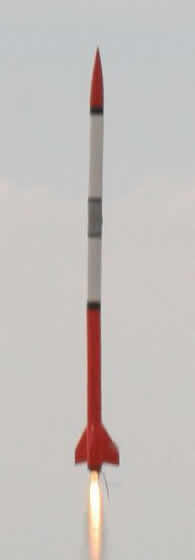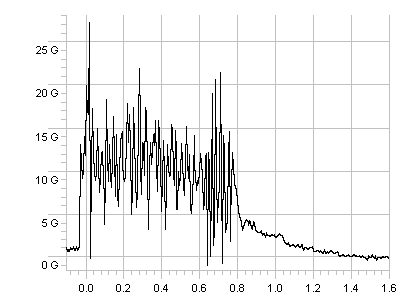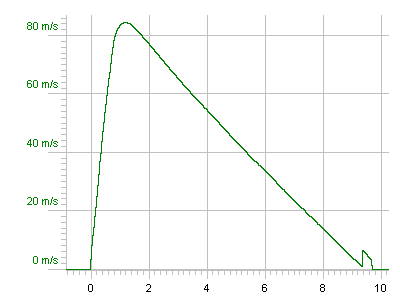R-DAS FLIGHT #20
R-DAS FLIGHT #20 DETAILS
INTRODUCTION

Photograph © copyright Brian Best
Canon EOS 20D
This was my 21st personal hybrid rocket flight, 20th personal flight with an RDAS that worked, and the sixth flight of the Hephaestus rocket, after a 3 year hiatus of launching this rocket. In the mean time, the rocket has been completely stripped down and repainted, and a new simpler, yet more advanced avionics bay for 2-stage recovery has been fitted.
AVIONICS
The new avionics bay is fitted with a Compact R-DAS, Perfectflite MiniAlt W/D altimeter and a Traxa RF Tracker, independent rechargeable NiMH 9.6 Volt battery packs, 3 SPST ultra miniature toggle switches, and a wiring loom using silicone coated wiring where possible. The altimeters, toggle switches and rechargeable battery packs are mounted to a G10 payload tray, with holes drilled with spacers fitted to separaten the altimeters from the G10 payload tray. The new avionics bay enables much more rapid prepping of the rocket, and much more rapid turnaround between launches.
The avionics bay is fitted with a bulkhead assembly at each end, consisting of an airframe bulkplate attached to a coupler bulkplate. Throught this bulkplate assembly, is fitted an M5 Seasure U-bolt, and holes are drilled through the bulkplates to fit a piece of M5 studding on either side of the bulkplate assembly. The M5 studding takes the shock loading when the recovery systems are deployed.
2 double terminal posts with red and black silcone coated wires soldered and heat shrunk onto the terminal posts, are fitted to each bulkplate assembly, with small holes drilled through the bulkplates, and the terminal posts permanently glued onto the bulkplate, with the wires running through into the internal section of the avionics bay. This configuration ensures there is no leak path for hot ejection charge gases to reach the internal section of the avionics bay.
FLIGHT DETAILS
The sixth flight was launched on the Hypertek I-205 hybrid rocket motor (using a 330cc oxidiser tank and a standard fuel grain). The rocket ascent was uneventful, with minimal weathercocking. The dual altimeters in the avionics bay provided redundancy, with independent main and drogue ejection charges on each altimeter (thus 4 ejection charges in total, 2 for drogue deployment, and 2 for main deployment).
RECOVERY
The drogueless deployment of the first stage of recovery, was chosen to reduce the downrange drift of the rocket following apogee. A drogueless first stage recovery, separates the 2 halves of the rocket via a long shock cord, and breaks up the aerodynamics of the rocket, causing it to tumble. This method also reduces the length of the recovery bay required for the drogue section.
The main recovery bay houses the 44" b2 C-II main parachute purchased from Pete's Rockets. I was amazed that this size parachute, together with the parachute harness and the shock cord, fitted in the 18" long main recovery bay used, but to my surprise, with some careful parachute packing, it did fit, although it was a tight fit. The parachute was protected from the ejection charge gases by a Nomex flame shield purchased from Pete's Rockets.
All 4 charges (2 from the Compact R-DAS, and 2 from the Perfectflite MiniAlt), fired at the pre set times during flight, with both altimeters working correctly. The rocket separated into 2 sections joined via the shock cord, at apogee via the drogue charges, for drogueless deployment. The main charge fired at 600 feet (Compact RDAS) to deploy the main 44" b2 C-II parachute, and the backup main charge firing at 500 feet (Perfectflite MiniAlt W/D). The rocket then descended gently to a safe landing, and was recovered intact.
R-DAS DETAILS
The Compact R-DAS was updated to the latest version 3.7 firmware before the launch, and the flight settings were set to use breakwire launch triggering with smart recovery. Although the latest RDAS firmware should cure previous problems with the oscillation in Hypertek motor combustion, which has has been known to result in irregular launch triggering of the R-DAS, it was decided that it would be prudent to launch a few times using the new R-DAS firmware in breakwire mode first. The R-DAS breakwire and smart recovery option worked perfectly, and both R-DAS ejection channels fired at correct times. A breakwire from Airborne Engineering Limited was fitted again.

Graph 1: Hephaestus Hybrid Rocket Flight #6 RDAS Full Data - 10/07/2005 |
 Photograph © copyright Brian Best Canon EOS 20D |

Graph 2: Hephaestus Hybrid Rocket Flight #6 RDAS Acceleration Data - 10/07/2005 |
|

Graph 3: Hephaestus Hybrid Rocket Flight #6 RDAS Velocity Data - 10/07/2005 |
| Flight #: | RDAS Flight 20 / Hybrid Flight 21 |
| Date: | 10th of July, 2005 |
| Venue: | Heckington, Lincolnshire |
| Weather: | Blue Sky, Minimal Cirrus Cloud |
| Wind: | Occasional Light Breeze |
| Temperature: | |
| Fins: | 3 clipped, swept deltas (Aerofoiled) |
| Launch System: | Rail Launch |
| Finish: | Painted |
| R-DAS FLIGHT DETAILS | |
| R-DAS Type: | R-DAS Compact |
| R-DAS Firmware: | 3.7 (released: 01/05/2005) |
| R-DAS Launch Detect Method: | Breakwire |
| R-DAS Recovery Mode: | Smart Recovery |
| R-DAS Recorded Maximum Acceleration: | |
| R-DAS Recorded Maximum Velocity: | 84.83 m/s (305 kmh / 184 mph) |
| R-DAS Recorded Maximum Altitude: | 1246 feet |
| Apogee - Charge Firing Delta-t: | 0 seconds |
| Apogee - Charge Firing Delta-h: | 0 feet (0 metres) |
| Descent Rate at Apogee Deployment: | 0 metres per second |
| Descent Rate at Main Deployment: | 22 metres per second (79.2 kmh / 47.7 mph) |
| Descent Rate at Landing: | 8.18 metres per second (29.5 kmh / 17.7 mph) |
| R-DAS Flight Mode: | 2-stage parachute deployment (Drogueless from Apogee & 44" Main Parachute at 600ft) |
| Total Time of Flight: | 42 seconds |
| Apogee - Charge Firing h Variance: | 0% |
| Apogee - Charge Firing t Variance: | 0% |
| PERFECTFLITE MINIALT W/D FLIGHT DETAILS | |
| Perfectflite MiniAlt W/D Firmware: | 1.2 |
| Perfectflite MiniAlt W/D Launch Detect Method: | Pressure Difference |
| Perfectflite MiniAlt W/D Recorded Maximum Altitude: | 1250 feet |
| Perfectflite MiniAlt W/D Flight Mode: | 2-stage parachute deployment (Drogueless from Apogee & 44" Main Parachute at 700ft) |
| Total Time of Flight: | 42 seconds |
| DIMENSIONS | |
| Launch Vehicle Diameter: | 68mm (2.6") |
| Launch Vehicle Total Length: | 1943mm (76.5") |
| Motor Bay Length: | 737mm(29") |
| Drogue Bay Length: | 368mm (14.5") |
| Avionics Bay Length: | 102mm (4") |
| Recovery Bay Length: | 457mm (18") |
| Nosecone Length: | 279mm (11") |
| WEIGHTS | |
| Launch Vehicle Gross lift Off Weight (GLOW): | |
| Launch Vehicle Dry Weight: | 2.82 kg / 6.2 lbs |
| Motor Gross Weight: | 1067 grams |
| Dry Motor Weight: | |
| Propellant Weight: | 298 grams |
| Motor Bay Dry Weight: | 2.4 lbs (with D-link fitted for recovery attachment and motor retainer, but without motor) |
| Motor Bay Loaded Weight: | 4.2 lbs (with Hypertek I-205 motor - combustion chamber and oxidiser tank) |
| Avionics Bay Loaded Weight: | 1.4 lbs (with 2 D-links fitted for recovery attachment) |
| Main Recovery Bay Loaded Weight: | 1.4 lbs (with parachute, harness, flameshield and shockcord) |
| Drogue Recovery Bay Loaded Weight: | 0.6 lbs (with harness, flameshield and shockcord) |
| Nosecone Weight: | 0.4 lbs (with D-link fitted for recovery attachment) |
| PROPULSION | |
| Launch Vehicle Propulsion: | Hypertek I-205 Hybrid Rocket Motor Designation: 330/54-125-J (0.125 injector orifice) |
| Motor Total Impulse: | 470 Newton seconds (46% I) (1) |
| Motor Specific Impulse: | 175 seconds (2) |
| Optimum Theoretical Burn Time: | 2.40 seconds (3) |
| Actual Useable Burn Time: | 3.10 seconds (4) |
| Maximum Thrust: | 344 Newtons (77.5 pounds) (5) |
| Nozzle Throat Diameter: | 0.453" (6) |
| Motor Total Length: | 546mm (7) |
| Motor Diameter: | 54mm (8) |
| RECOVERY | |
| Recovery Type (Stage #1): | Drogueless deployed at apogee |
| Recovery Type (Stage #2): | b2 C-II 44" Main Parachute deployed at 600ft |
| Ejection Method: | 2 Ejection Charges for drogue (R-DAS & MiniAlt) 2 ejection charges for main (R-DAS & MiniAlt) |
| Ejection Ignition Type: | E-matches |
| Recovery Attachment Fixings: | M5 U-Bolts (Seasure) |
(1),(2),(3),(4),(5),(6),(7),(8) - Data Copyright © Tripoli Rocketry Association 1996-1998
COMPONENT SOURCES
PML 2.6" diameter Airframe Tubing and Nosecone - Pete's Rockets.
Hypertek 54mm diameter, I-class Hybrid Motor - Pete's Rockets.
Hypertek Hybrid Rocket Fuel Grain - Uncle Bob's Rocket Shop
AED Compact R-DAS - AED
Perfectflite MinIAlt W/D - Rockets and Things
54mm diameter Motor Retainer - Pete's Rockets
b2 C-II Parachute - Pete's Rockets
9.6 Volt NiMH Rechargeable Battery Pack - modelpower.co.uk
See Also
Hybrid Rocket Science, Amateur Motors, Amateur Liquid Rockets, Guidance, Gimballed Motors, Launch Controller

